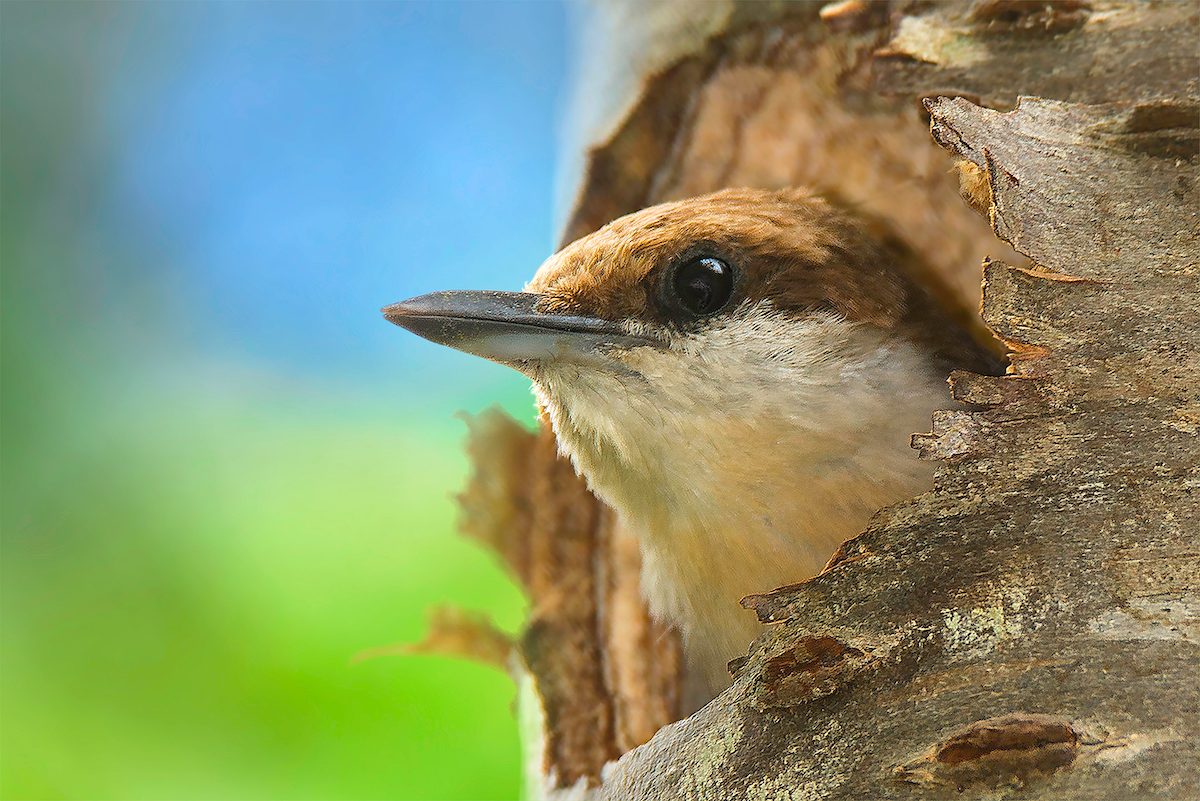Learn how to identify a brown-headed nuthatch. See photos of what these birds look like, find out what they eat and where to spot them.

Identify and Attract a Brown-Headed Nuthatch

On This Page
What Does a Brown-Headed Nuthatch Look Like?

These brown-capped songbirds sport a white nape spot and pale off-white underparts. Male and female brown-headed nuthatches look similar. They measure about four inches long.
These small, short-tailed songbirds are very acrobatic. In addition to climbing up trees, these nuthatches can maneuver headfirst down, finding insects in bark crevices missed by upward-only climbing birds, such as woodpeckers.
Did you know: The size, shape and plumage of the brown-headed nuthatch is similar to a pygmy nuthatch. The best way to tell the difference between these birds is by their range.
Meet the white-breasted nuthatch.
Brown-Headed Nuthatch Nesting Habits

These year-round residents mate for life, and start building cavity nests in early February while snakes are hibernating, Jim says. “They’re easy prey for snakes, which basically shimmy up the tree and take the young and sometimes the female.”
Both sexes look for a dead tree or snag, typically a pine but sometimes a deciduous tree or fence post near a pine forest. “They look for soft dead trees in the last stages of decay,” says Jim Cox, a biologist at Tall Timbers, a research station and land conservancy in Tallahassee, Florida. Nests consists of grass, bark fibers, hair, feathers and pine seed wings.
These tree climbers defend territories of up to 5 acres, and produce four to six eggs, which the female incubates for about 14 days.
Young may fledge in about 18 days but some fledglings stick around—a behavior known as cooperative breeding. It is mostly males that remain for a year or two, helping their parents build a nest and feeding the incubating female or the new nestlings.
“If there’s a vacancy next door, they’ll take over that territory,” Jim says, who estimates cooperative breeding increases the chances of nesting success from 45% to 60%.
Family members frequently groom one another in a highly social behavior called allopreening.
Learn how to identify and attract a red-breasted nuthatch.
Do Brown-Headed Nuthatches Use Birdhouses?
Jim says he has had success attracting them with nest boxes. Use a metal excluder attached over the 1 1/2- inch hole on a bluebird box to makes it 1 1/8 inches in diameter and just right for these birds.
Learn how to identify a brown creeper.
Brown-Headed Nuthatch Sounds and Calls
Bird sounds courtesy of the Cornell Lab of Ornithology
You may hear these talkative birds before you see them.
Whether foraging atop trees or nesting in low snags, brown-headed nuthatches are often chattering with one another. “It’s a coordinated back and forth between group members until they come across a group of neighboring nuthatches. Then all hell breaks loose as they defend their space against the other group,” says Jim.
To tell males and females apart, Jim suggests listening. “Females have a chattery series of staccato notes while males have a distinct voice that sounds like a squeaky dog toy.”
Nuthatch vs chickadee: here’s how to tell the difference.
What Do Brown-Headed Nuthatches Eat?

Their diet mainly consists of insects and pine seeds. If you live in their range and are near five to 10 acres of mature pine forest, you can attract brown-headed nuthatches with suet and sunflower seeds.
These clever birds use their chisel-like beaks to pry off pieces of bark, which they use to dig beneath flakes of bark searching for insects.
“It’s a pleasure to spot brown-headed nuthatches foraging among the pine needles and tree bark for seeds and insects. Very few birds use tools, but these nuthatches often pry bark up from a tree using another piece of bark to search for insects. They are active feeders, moving up, down and around trees very quickly, which means photographing them can be quite a challenge. Just watching them always brings a smile to my face,” says Michael Fitzgerald of Merritt Island, Florida.
Range and Habitat

Look for these birds in mature pine forests of the southeastern United States. from the Delmarva Peninsula to Florida and east Texas. They are nonmigratory in their range.
About the Experts
Biologist Jim Cox heads up the Stoddard Bird Lab at Tall Timbers, a research station and land conservancy in Tallahassee, Florida. He has a master’s degree in avian ecology and evolution from Florida State University. His research focuses on the conservation and management needs of several declining species of birds associated with southern pine forests, including brown-headed nuthatches.
Sources
- National Audubon Society – Brown-headed nuthatch
- All About Birds – Brown-headed nuthatch
- American Birding Association
- North Carolina Audubon
- Audubon – Nuthatches Take Up Nannying When There’s a Shortage of Mates






















